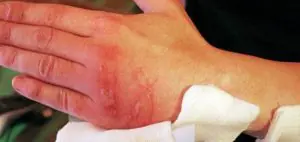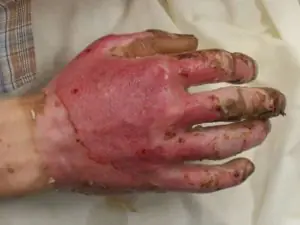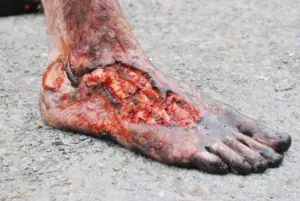A thermal burn is damage to body tissues due to their contact with hot substances or objects: high-temperature liquid or steam, open flame, hot surfaces.
Skin damage in the form of burns can occur both at home and at work with approximately the same frequency:
- The most common are flame burns 50-70%,
- scalding with liquids or steam occurs in 20% of all burns,
- exposure to hot objects accounts for 10%.
There are 4 degrees of burn, based on data on the depth of penetration, temperature, time and area of its influence. This division is extremely important for choosing treatment measures and determining the prognosis for recovery after a burn.
Symptoms
Currently, four degrees are used in the classification of thermal burns on the skin, based on their spread deep into the tissue. In accordance with it, the signs of a thermal burn are identified.
- Idegree.
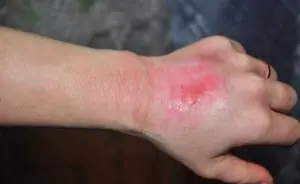
The burn is limited to the most superficial layers of the epidermis. Sharp redness of the skin, some swelling, severe pain and burning. After 3-4 days, its upper layers dry out, darken and subsequently separate in the form of small scales. At the site of injury after a burn, skin of the usual appearance remains.
|
|
|
Burns I – IIIA are called superficial, IIIB and IV – deep. Of course, IV degree of thermal burn is the most unfavorable for the patient. However, superficial damage can become fatal if the damage is large.
How to determine the affected area
- Rule of nines. The area of each body part is equal to 9% or 18% of the total area, for a total of 100%. The exception is the perineum, which occupies only 1%. In this way, the overall percentage of burn spread throughout the body is calculated.
- Palm rule. The area of the burn is compared with the area of the victim's palm, taken as 1%. The counting principle is the same.
- Vilyavin's schemes. Silhouettes of the human body on paper, divided into squares. A schematic representation of burns is applied to them and the percentage of the total area is also recorded.
First aid
First aid measures for thermal burns should be carried out as soon as possible, preferably immediately after contact with a hot object or scalding:
- Be sure to protect the victim by eliminating the source of the burn - extinguish the open flame, turn off hot electrical appliances, and keep away from heated steam or liquid as much as possible. It is especially important to extinguish a flame that has engulfed clothing directly on a person by throwing it off, pouring water or fire extinguisher foam, or covering it with sand or snow. If exposed to sunlight, move it to the shade.
- Try to calm down the people around you and, most importantly, the victim himself. Consistently find out the circumstances of the thermal injury.
- Do not touch the wound and do not separate pieces of clothing or soil stuck to the burn, do not puncture blisters, etc.
- Cool the burned skin areas with cold running water or in a container of clean, cool water for 15-20 minutes. This is necessary because heated tissue continues to be damaged even after the source of the burn is eliminated. Using an ice pack is not advisable; it can lead to frostbite.
- Do not lubricate the injured area with sunflower oil, fermented milk products, or alcohol tinctures. Do not cover the burn with plant leaves.
- Prevent bacteria from entering the burn wound by covering it with an aseptic dressing - a clean, dry bandage or gauze that completely covers the edges of the defect. The use of cotton wool is unacceptable: it will certainly remain on the burned tissues in the form of thin, adherent fibers.
- The first aid measure for burns on the limbs is their immobilization (limitation of movements). Use any available means - boards, wide beams, narrow sheets of plywood, etc.
- Anesthetize the victim with any available drug:
- Ibuprofen – 20-50 rub.
- Nise (nimesulide) – 220 rub.
- Nurofen – 80-100 rub.
- Analgin – 10-50 rub.
- Baralgin – 200-220 rub.
- Ketanov – 60-200 rub.
- In case of symptoms of burn shock (severe weakness and pallor, drop in blood pressure, rapid pulse, irregular breathing rhythm, cold sticky sweat), it is necessary to give plenty of fluids and insulate the victim.
- Call an ambulance to hospitalize a patient with severe burns to a specialized clinic or department of a multidisciplinary hospital.
Typically, first aid to a person who has received a thermal burn is provided by people around them who are not medical workers. The recovery of the victim depends on knowing the exact actions in such a situation and their speed. For a first-degree thermal burn with a small spread, first aid does not include calling an ambulance; you can treat it yourself.
Treatment
Methods for treating thermal burns are divided into:
- local (related directly to the burn site);
- general (correct disorders at the level of the whole organism).
In turn, local methods are represented by conservative and surgical procedures, the choice of which depends on the degree of the burn.
Local treatment
It is usually not possible to visually examine the differences between II and IIIA burns, so they should be conditionally combined into II degree, and IIIB into III. This is also necessary to simplify the understanding of therapeutic actions.
For superficial burns of a small area, measures begin with the “toilet” of the wound. It is carried out very carefully, under general anesthesia. The skin around the burn wound is disinfected with an antiseptic solution (chlorhexidine), and contamination is removed.
Wounds with heavy contamination are cleaned with a 3% solution of hydrogen peroxide. Large layers of exfoliated epidermis, on the contrary, are left behind: they then become a kind of “natural bandage” for the burn. Next, choose one of the conservative methods of wound management - open or closed (under a bandage with medications).
Currently, the closed method is more often used:
- For a 1st degree thermal burn, a single application of a bandage with a water-soluble ointment with an antibacterial effect is sufficient:
- Levomekol – 100-150 rub.
- Levosin – 70-100 rub.
- Betadine (betidine ointment) – 250-300 rub.
To increase the effectiveness of therapy, dressings are supplemented with minor surgical removal of necrotic tissue. Complete closure of the defect can be achieved using water-soluble ointments and skin grafting - one of the types of surgical treatment of burns.
With the open method of wound management, doctors achieve the rapid growth of a dry crust - a scab - which will be a natural “barrier” to infection. Effective:
- Drying effect of air.
- Ultraviolet.
- 5% potassium permanganate – 50 rub.
- Brilliant green alcohol solution – 10-50 rub.
Surgical treatment is mandatory when correcting burns of degrees III and IV. It includes one of the options:
- Simultaneous dissection of burned tissues to structures undamaged by the burn.
- Simultaneous removal of all dead tissue with the application of skin “substitutes” - grafts - to the defect.
- Skin grafting (with your own muscles or healthy skin from other parts of the body) after conservative treatment of a burn.
General treatment
All measures are aimed at replenishing impaired body functions after the appearance of a thermal burn:
- Fighting pain:
- Rest the affected area of the body.
- The use of non-narcotic pain medications in tablets or injections (NSAIDs).
- Supports normal heart and lung function.
- Replenishing the deficiency of the liquid part of the blood and eliminating intoxication by administering a solution of sodium chloride.
- Replenishment of blood cell deficiency.
- Preventing infection by administering antibiotics, namely:
- Ceftriaxone – 20-50 rub.
- Cefotaxime – 20-120 rub.
- Ceftazidime – 80-130 rub.
- Cefoperazone – 430-450 rub.
Medical care for thermal burns is provided in special combustiology departments. All conditions have been created there for the fastest healing of tissues: from air mattresses to a certain temperature in the wards.
Forecast
Burns from high temperatures are not as harmless as they seem at first glance. The prognosis for a particular victim depends on the depth and area of damage and is determined using the Frank index as one of the options:
- favorable;
- relatively favorable;
- doubtful;
- adverse.
Thermal burns in older people and children have a high percentage of deaths. In other patients, the following are critical:
- First degree burn with 100% spread throughout the body.
- Thermal burns of the second and third degree with damage to 1/3 of the skin area.
- Third or fourth degree damage affecting more than 15% of the surface of the limbs and torso or a burn in the perineum, face, neck.
Thermal burns of the mucous membranes of the oral cavity and respiratory tract significantly worsens the prognosis. More often this happens when suddenly inhaling hot steam.
What is a thermal burn?
A thermal burn is a burn that occurs through contact with a liquid, solid, or gaseous heat source. Such a heat source can be hot bodies, flames, steam, or hot liquids. The first place in statistics is occupied by flame burns (about 84% of all thermal burns), followed by burns with liquid substances and electrical burns (approximately 7% for each type). In 2% of victims, burns were caused by other factors.
A thermal burn can damage several layers of skin at once: epidermis (outer layer), dermis, subcutaneous tissue. Depending on the number of damaged layers, four degrees of thermal burns are distinguished. Often a burn includes all these degrees at the same time. Many doctors, when describing burns, classify them according to the depth of the damage: superficial, partial, complete.
The severity of the burn also depends on the area of the affected tissue. It is expressed as a percentage relative to the area of the entire surface of the skin. When roughly assessing a burn, the so-called “palm rule” is used: the area of the human palm is equal to one percent of the body area.
Degrees of thermal burns
It is customary to distinguish four degrees of burns depending on the depth and severity of the injury. Burns of the 1st and 2nd degrees are considered superficial, 3rd and 4th - deep.
First degree thermal burn. The affected area swells and turns red. A person is disturbed by pain and burning, especially acutely felt when touched. The skin temperature in the affected area increases. The listed symptoms last for 2, sometimes 3 days, gradually disappearing. The burn site continues to disturb the victim for some time; the epidermis begins to peel off. Gradually (after 3-5 days) the injured area looks almost healthy.
Thermal burn of the second degree. This burn occurs due to prolonged or sudden exposure to high temperature. There is also redness and swelling of the tissues, but blisters also form. They are filled with tissue fluid exuding from dilated skin vessels. Later, the contents of the blisters, due to protein coagulation, turn from a transparent mass into a jelly-like mass containing leukocytes. The tissue fluid and the skin of the blisters themselves protect the tissues located under the lesion from injury and infection; for this reason, the blisters cannot be opened.
Patients with a second degree burn typically suffer from severe pain. But after a few days, tissue irritation and circulatory disturbance begin to decrease, and the liquid is gradually absorbed. At the bottom of the blisters, epidermal cells are actively dividing, and after a week a new stratum corneum begins to appear.
Third degree thermal burn. It occurs during prolonged exposure to high temperatures. It is characterized by skin necrosis - tissue necrosis, which can be dry or wet. When tissue is exposed to steam or boiling water, wet necrosis usually occurs. The skin becomes swollen, pasty, acquires a yellowish tint, and may become covered with blisters.
This inflammation occurs in a manner similar to the melting of dead tissue. When necrosis is dry, the skin is also dry, dense, dark brown or black. The edges of the area with dead tissue are clearly visible. Healing of burns of this degree occurs through scarring. However, when at least small areas of the germ layer of the epithelium are preserved, epithelization cannot be ruled out.
IV degree thermal burn. This, without exaggeration, is the most terrible degree of burns. Often such burns cover a large area. All layers of the skin and even tissues located outside it die: subcutaneous fat, tendons, muscles, bones. Several large blisters often merge into one huge one; the skin color becomes dark red, reaching black. Such damage threatens not only human health, but also human life.
III and IV degree burns are, of course, more dangerous, but superficial burns can also be fatal if they involve more than a third of the body surface.
First aid for thermal burns
The first thing to do as quickly as possible is to extinguish the flame (if there is one) on the victim’s clothing and skin. It is necessary to throw off burning clothes from a person or throw a cloth over his body to stop the access of air to the fire. A burning area of clothing can be covered with earth, sand, snow, or doused with water.
Try to calm the victim and the people around him.
Carefully remove from the injured person any smoldering remains of things that do not get into the wound. Under no circumstances should you remove clothing that is stuck to a burn. You should also not touch the burned body with your hands.
If it is a sunburn, you need to move the affected person to the shade.
If you do not have information about what happened, quickly clarify the circumstances of the accident (“the child knocked over a bowl of hot broth,” “clothes caught fire from the fire,” etc.).
Hold the affected part of the body for 10-20 minutes under running cold running water (you can put it in a container with cool, clean water). This must be done so that the heated wound does not deepen or expand. In addition, it activates blood circulation in the wound. However, ice should not be used to cool the burned area to avoid the possibility of another injury - frostbite. In extreme cases (if there is no water nearby), cooling the wound with urine is allowed, but in practice there is almost never a reason to use this method.
Apply any available anti-burn agent to the affected surface, and apply a sterile (if possible) dry bandage on top. You cannot use cotton wool, only gauze, bandages - fabric materials. It happens that you have neither anti-burn agent nor sterile bandages at hand, then you should apply any dry, clean bandage to the wound. You should not apply any folk remedies to the burn: vegetable oil, vodka solutions, kefir, sour cream, etc. You should also not apply Kalanchoe or aloe leaves or other “miracle remedies” to the burned skin. In case of a first degree burn (if there is no extensive damage to the skin or blisters), the bandage may not be applied at all, only an anti-burn spray can be applied.
If there are extensive burns of the extremities, you need to carefully fix them with a splint (any available means), raising the burned arms (legs).
If a large area of the body is burned and there are signs of burn shock (the person is weak, pale, has increased anxiety, there is tachycardia and a drop in blood pressure, cold sweat, breathing and heart rate are disturbed), you should give him as much liquid as possible to drink - juice, compote or plain clean water. Thanks to the intake of fluid into the body, intoxication resulting from the penetration of decay products of burnt tissue into the blood will decrease.
If the victim complains of pain, then in order to avoid painful shock, you should give him any available painkiller (spasmalgon, analgin, etc.).
If a person has no cardiac and (or) respiratory activity, cardiopulmonary resuscitation (artificial respiration, chest compressions) should be performed.
In case of severe burns, call an ambulance for hospitalization of the victim or independently deliver him to a specialized medical institution. It is preferable to use the services of an ambulance, since not everyone can accurately say in which hospital or department burns are treated. It’s good when it’s a specialized clinic or at least a specialized department.
Treatment of thermal burns
Treatment of thermal burns involves the use of various means.
These can be creams and ointments, gels and sprays, or special dressings impregnated with a medicinal composition:
Antibacterial and wound-healing ointment Levomekol is often used to treat burns. The use of this product allows you to achieve an analgesic effect. Levomekol can be applied from the first day after receiving a burn.
Povidone-Iodine ointment is aimed at accelerating tissue regeneration and also prevents infection from penetrating deep into the wound. This is possible thanks to the iodine included in the ointment, which acts as an antibacterial component.
If a person prefers to use products based on natural ingredients, then you should opt for the Rescuer balm. It contains no synthetic antibiotics or hormones. Applying the balm to the burn will allow the damaged tissue to heal in the shortest possible time.
For household burns, Panthenol Spray with dexpanthenol has proven itself well. Unlike analogues, which are cosmetics, this is a certified medicinal product. It does not contain parabens, making it safe for both adults and children from the first day of life. It’s easy to apply—just spray it on the skin without rubbing. PanthenolSpray is produced in the European Union, in compliance with high European quality standards; you can recognize the original PanthenolSpray by the smiley face next to the name on the packaging.
A burn is always painful. Often even the application of medications is accompanied by painful sensations. In this case, experts recommend using sprays. The method of their use is reduced to contactless spraying onto the affected surface, which ensures minimal discomfort during treatment.
You can also find anti-burn dressings on sale that are soaked in medicinal solutions. They allow you to relieve pain, accelerate healing and disinfect affected tissues.
To treat thermal burns, gels are often used, for example, Apollo and Burns net. They are suitable for primary wound treatment, as they have an antiseptic effect. These gels also make it possible to relieve pain and speed up healing. Therefore, they can be used at any stage of treatment. As studies show, the use of gels allows you to quickly clean the wound from dead tissue and prevent inflammation, which is the best prevention of further formation of scars.
If you get a serious burn, what should you do?
Of course, you need to see a doctor or, as a last resort, call an ambulance. In a specialized clinic (specialized department), under anesthesia, initial gentle treatment of wounds and the skin surrounding them is carried out with gauze wipes soaked in warm soapy water or a 0.5% solution of ammonia. After this, the burn surface is carefully washed with warm water or alcohol (40-70 degrees), dried and irrigated with antiseptic solutions.
Very dirty burn areas are cleaned with a 3% hydrogen peroxide solution. Particles of the epidermis are removed from superficial burns with tweezers or scissors. Small blisters are not opened, but large detached blisters are cut at the base and then emptied by lightly pressing them with a gauze swab. For burns caused by tar or bitumen, use purified gasoline.
With the open method of treatment, a thin layer of a special ointment or another synthetic (biological) coating is applied to the surface of the wound. With a closed method of treatment, a bandage with a special ointment (synthomycin, streptomycin) or emulsion (for example, sulfidine) is applied to the burn. Vishnevsky's anti-burn oil-balsamic emulsion is also effective. Such dressings do not interfere with the healing of the burn, do not cause pain when changing, and provide high-quality protection of the wound from infection. The bandage is carefully bandaged, lightly pressing on the tissue. It should not move; if the disease progresses successfully, the bandage is not removed until 7-9 days. This period of time is enough for the burn surface to epithelialize.
If the limbs are burned, immobilization is required, i.e. temporary immobilization. Any position convenient for the victim can be selected. In order to avoid the negative consequences of immobilization, every 2-3 days it is necessary to pause immobilization in order to make movements in the joints.
There is no single correct opinion on what should be done with burn blisters. Some doctors quickly remove them, explaining that their internal contents are not sterile; other doctors release liquid from the blisters, but do not remove the blisters themselves.
To restore the body of a victim who has received a fourth-degree burn, prompt, competent treatment and skin grafting are required.
Forecast of thermal burns
Pathophysiological changes that inevitably develop in the body affected by a burn provoke disturbances in the vital systems of the body and even threaten human life. The prognosis largely depends on the area of the lesion, the extent of the lesion and the age of the victim. Mortality from burns is high in old people over 60 years of age and children under 3 years of age. However, even for patients of this age, burns cannot be considered a death sentence.
A critical condition is considered to be 100% - a total burn of the first degree, and burns of the second-third degree when more than a third of the body surface is affected. Life-threatening are third- and fourth-degree burns that affect the genitals, face, perineum (if they affect 10% of the body surface), and burns of the torso and limbs if the affected area is more than 15%. For more accurate predictions of burns, special methods have been developed - the “Rule of Hundreds”, “Frank Index”, which take into account the depth, extent of the affected area and the age of the victim.
You need to know: if the thermal effect on the skin lasts longer than 1 minute and exceeds 45 ° C, this inevitably leads to overheating of cells and their death due to inactivation of enzymes, protein denaturation, paralysis of tissue respiration and other metabolic disorders. After the cessation of thermal exposure, hyperthermia in the tissues does not stop, but continues and even becomes more active!
Author of the article: Volkov Dmitry Sergeevich | Ph.D. surgeon, phlebologist
Education: Moscow State Medical and Dental University (1996). In 2003, he received a diploma from the educational and scientific medical center for the administration of the President of the Russian Federation.
One of the most common types of injuries is thermal burn. It can be obtained by close contact with an open source of fire, by touching hot objects and liquids, and steam is also a great danger. It is highly desirable for every person to know safety precautions when working with elevated temperatures and the rules of first aid for such injuries. It is the timely provision of emergency care that determines the time of further treatment of burns, their consequences, and sometimes even life. In this article we will look at what a thermal burn is and what types they are. How to treat them and what can and cannot be done.
What is a thermal burn and what are its features?
These types of damage occur when the skin is exposed to high temperatures. This type of burn is quite easy to get if you are not careful when dealing with high temperatures. Children are especially susceptible to such injuries, but even adult men and women are not always careful and attentive.
Regarding complications, children and the elderly are most susceptible to them, while young and middle-aged people, on the contrary, more easily endure injuries. So, if with a thermal burn in children, complications can appear if 5 percent of the body is damaged, then in adults they can only appear if the damage is more than 20 percent of the body surface, but if the injuries are deep, then 10 may be enough to disrupt the functioning of internal organs. percent.
For pregnant women, receiving thermal burns can harm not only herself, but also the fetus, so it is strongly recommended that treatment be carried out under the supervision of a doctor.
Depending on what caused the damage, a burn has its own distinctive features. For example, an injury received from contact with boiling water is visually very different from that received from fire.
Signs and symptoms
A thermal burn occurs when body tissue is damaged by exposure to very high temperatures. Symptoms depend on the extent of the damage. So, with minor damage, the area of the body may just turn a little red and slight swelling will appear, and in more severe cases, blisters and even open deep wounds, as well as charring, will appear. In the most severe cases, tissue necrosis and damage to internal organs occur. Like all injuries, burns are accompanied by pain and very severe injuries can cause burn shock.
Types of thermal burns and their classification
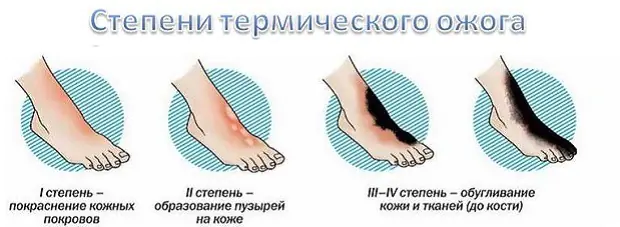
Thermal burns are classified into 4 degrees. Grades 1 and 2 refer to the type of mild injuries without penetrating the skin, and degrees 3 and 4 are classified as severe, with injuries of a penetrating nature.
- 1st degree. The affected area becomes red and swollen. Pain and burning are felt, and the temperature rises in the area of the burned area of the body. It goes away in a maximum of a week and leaves no marks on the body.
- 2nd degree. When a burn occurs, blisters and swelling appear; the blisters contain clear liquid inside them. A victim of a 2nd degree burn usually experiences severe pain, but after 3 days it gradually disappears and a new layer of skin forms.
- 3rd degree. Necrosis of all layers of skin occurs. The burned surface area is covered with a dark brown scab in case of a fire burn and a pale gray scab in case of a liquid or steam burn. The wound is cleared of pus within 5 weeks and upon healing a scar is formed from the secondary layer of skin.
- 4th degree. The cause of this type of burn is extremely high temperature and is considered the most dangerous degree of injury. The skin is charred, and the depth of the damage is very large. The resulting scab is very thick. Tendons, bones and muscles are affected. Healing is very slow and complications occur in most cases.
First aid and treatment
You need to know how to provide emergency medical care for a thermal burn, what to do in case of a thermal burn, and what rules for treating the surface of wounds must be strictly followed.
First of all, the burned person is assisted in cooling the injury site, which will help prevent more serious injuries and reduce pain. To do this, the burned surface area for first and second degree burns must be rinsed with cold, clean water for 20 minutes. Afterwards, the damaged area must be immersed in water for 30 minutes. Next, apply a bandage of gauze bandage or clean cloth to the surface of the burn, having previously treated the burned area and the skin nearby with an antiseptic.
To prevent burn shock in an injured person, you should give him a warm drink, as it also helps remove toxins that are formed during combustion.
Next, you need to give a painkiller that will help relieve the pain. The victim can be given ibuprofen, novocaine, baralgin or analgin. Novocaine needs to be treated over the entire area of the burned surface of the body.
Thermal burns of the first two degrees can be treated at home, but severe injuries of the third and fourth degrees can only be treated in a hospital under the supervision of doctors.
For treatment, healing dressings are used using ointments such as: levomekol, zinc ointment, rescuer or Vishnevsky ointment. First, you need to disinfect the affected area and its surroundings with 3 percent hydrogen peroxide, then carefully apply a layer of healing ointment or gel and apply a bandage or other breathable and sterile fabric. Drugs for the treatment of burns should be used in strict accordance with their instructions. Sea buckthorn oil and cabbage leaves also help heal burns, but these are folk remedies. Treatment methods for thermal injuries such as burns directly depend on their classification
What not to do and what complications may arise
A victim of a thermal burn should never be left alone, tear off clothing stuck to the wound, apply fat or ointment to the wound, the affected area should not be left open for more than an hour, it is forbidden to puncture or burst blisters, and it is forbidden to use ice to cool the damaged area.
Infectious consequences from burns are among the most dangerous. They manifest themselves mainly due to a negligent attitude towards injury, non-compliance with treatment rules and self-medication without understanding at least a little about medicine. This complication is accompanied by suppuration of the affected area, and in advanced cases it can lead to blood poisoning and further very sad consequences, such as amputation and even death. Therefore, you should approach the treatment of injuries of this kind consciously and not engage in amateur activities. If you don’t know how to treat this type of injury, such as thermal injuries, then you need to see a doctor who specializes in burns.
«>



